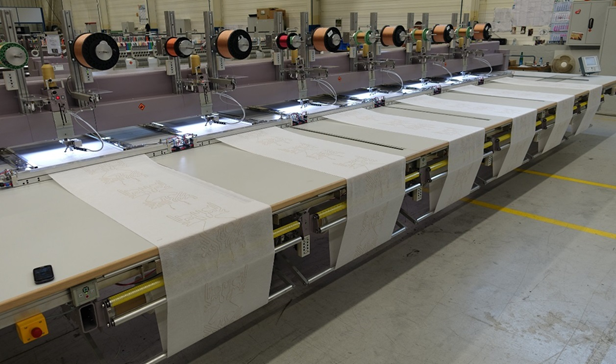Electronics manufacturing and scalability
Section outline
-
One of the key considerations when evaluating an e-textile prototype is its scalability. This refers to the ability to increase production volume quickly and cost-effectively. In the context of e-textiles, small batch manufacturing solutions can produce less than 500 parts per day. This is achievable depending on the size and complexity of the design, using a single head roll2roll machine.
With this type of machine, a roll of fabric is inserted into the front of the machine. The fabric is then automatically pulled through the machine, where it undergoes the embroidery process. This process involves the precise movement of the fabric under the needle, orchestrated by components such as the thread take-up lever and rotary hook, which ensure consistent stitching. After embroidering, the fabric is fed to a feeder roll located at the back of the machine for collection. The single head roll2roll machine is a marvel of modern textile technology, seamlessly integrating traditional embroidery techniques with automated processing. Such machines are crucial for applications requiring high precision and repeatability, such as in the production of sensors and conductive pathways in smart textiles.

JGW Single Head Roll2Roll Machine for Small Batch Manufacturing
Embroidery, being a time-honored textile process, comes with a wide array of production machine configurations. This robustness significantly reduces the risk associated with scaling up production, especially when compared to newer, less-established e-textile processes. Fully automatic and scalable roll to roll solutions exist and are heavily utilized in industries such as car seat heating, where conductive threads are embroidered to create heating elements, and other technical textile sectors like medical textiles for monitoring health parameters.

Interestingly, many traditional embroidery companies can adapt their existing equipment setup to transition their production from traditional embroidery to technical e-textiles embroidery. This adaptability is facilitated by the modular design of embroidery machines, which often allows for the integration of additional components such as sensors and actuators needed for e-textile applications. This is a testament to the flexibility and adaptability of embroidery technology in the face of evolving textile needs. For example, the bobbin case, a critical component in maintaining thread tension, can be adjusted to accommodate conductive threads, which may have different properties compared to standard embroidery threads.

Learn More:
- ASTM Textiles Standards: Learn more about international standards for textiles.
- ISO E-Textiles Standards: Understand the international standards for e-textiles.
- E-textiles: Fabric circuits and commercial sewing machines: A research paper that explores the integration of circuits into fabric using commercial sewing machines.
